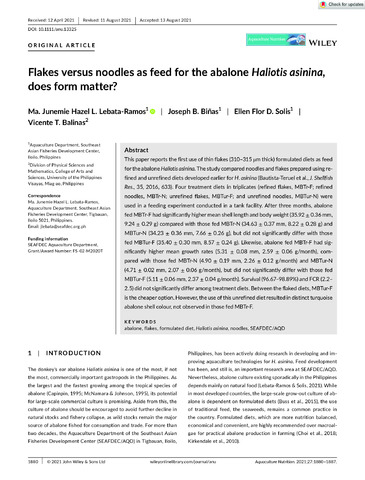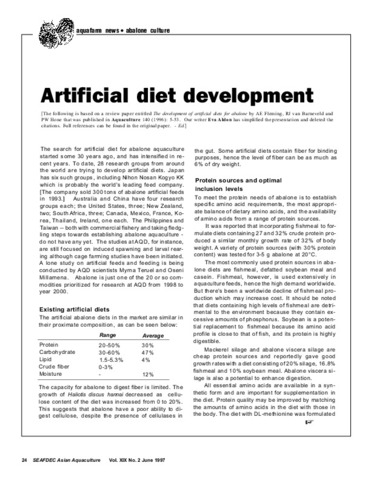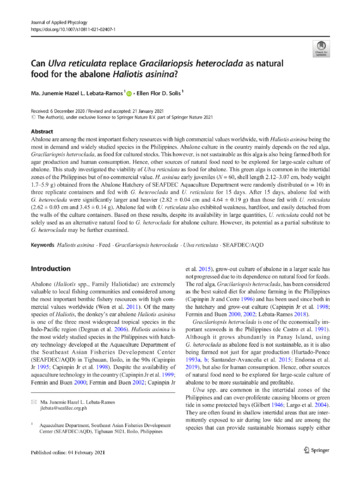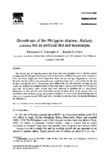Flakes versus noodles as feed for the abalone Haliotis asinina, does form matter?
Share
Abstract
This paper reports the first use of thin flakes (310–315 μm thick) formulated diets as feed for the abalone Haliotis asinina. The study compared noodles and flakes prepared using refined and unrefined diets developed earlier for H. asinina (Bautista-Teruel et al., J. Shellfish Res., 35, 2016, 633). Four treatment diets in triplicates (refined flakes, MBTr-F; refined noodles, MBTr-N; unrefined flakes, MBTur-F; and unrefined noodles, MBTur-N) were used in a feeding experiment conducted in a tank facility. After three months, abalone fed MBTr-F had significantly higher mean shell length and body weight (35.92 ± 0.36 mm, 9.24 ± 0.29 g) compared with those fed MBTr-N (34.63 ± 0.37 mm, 8.22 ± 0.28 g) and MBTur-N (34.23 ± 0.36 mm, 7.66 ± 0.26 g), but did not significantly differ with those fed MBTur-F (35.40 ± 0.30 mm, 8.57 ± 0.24 g). Likewise, abalone fed MBTr-F had significantly higher mean growth rates (5.31 ± 0.08 mm, 2.59 ± 0.06 g/month), compared with those fed MBTr-N (4.90 ± 0.19 mm, 2.26 ± 0.12 g/month) and MBTur-N (4.71 ± 0.02 mm, 2.07 ± 0.06 g/month), but did not significantly differ with those fed MBTur-F (5.11 ± 0.06 mm, 2.37 ± 0.04 g/month). Survival (96.67–98.89%) and FCR (2.2–2.5) did not significantly differ among treatment diets. Between the flaked diets, MBTur-F is the cheaper option. However, the use of this unrefined diet resulted in distinct turquoise abalone shell colour, not observed in those fed MBTr-F.
Suggested Citation
Lebata-Ramos, M. J. H., Binas, J., Solis, E. F., & Balinas, V. T. (2021). Flakes versus noodles as feed for the abalone Haliotis asinina, does form matter? Aquaculture Nutrition , 27(6), 1880-1887. https://doi.org/10.1111/anu.13325
Subject
Collections
- AQD Journal Articles [1248]
Related items
Showing items related by title, author, creator and subject.
-
Artificial diet development [for abalone]
Aldon, Eva (Aquaculture Department, Southeast Asian Fisheries Development Center, 1997) -
Can Ulva reticulata replace Gracilariopsis heteroclada as natural food for the abalone Haliotis asinina?
Lebata-Ramos, Ma. Junemie Hazel; Solis, Ellen Flor D. (Springer, 2021-02-04)Abalone are among the most important fishery resources with high commercial values worldwide, with Haliotis asinina being the most in demand and widely studied species in the Philippines. Abalone culture in the country ... -
Growth rate of the Philippine abalone, Haliotis asinina fed an artificial diet and macroalgae
Capinpin, Emmanuel C., Jr.; Corre, Kaylin G. (Elsevier, 1996)The growth rate of Haliotis asinina fed three diets was evaluated over a 120 day period. Juveniles fed the red alga Gracilariopsis heteroclada and an artificial diet grew faster in terms of both total body weight and shell ...




